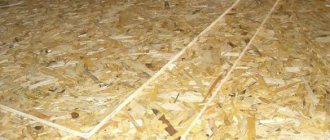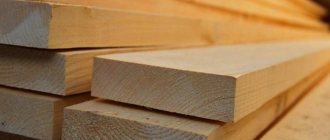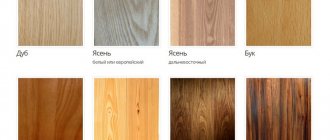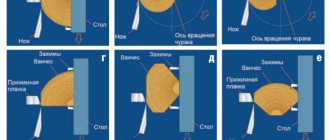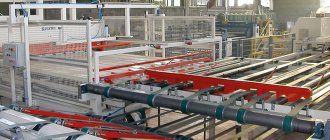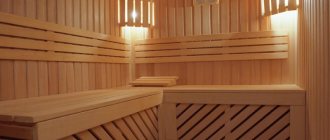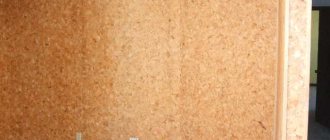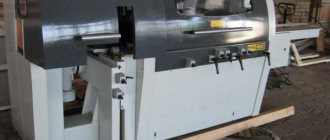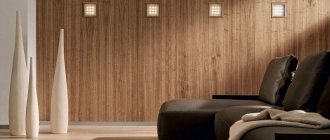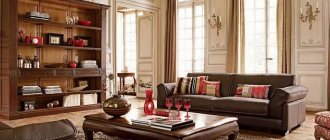Chipboard
— Chipboard is a sheet composite material produced by hot pressing of wood and woodworking waste, mainly shavings and sawdust, with a binder of non-mineral origin.
If it is necessary to obtain special properties from chipboard
or due to the peculiarities of the technological process, special additives can be added to the composition in a volume of 6 - 8% by weight of the main filler (chips).
In English, the concept of chipboard sounds like this: particle board
, which literally means - Board of Particles.
History of the creation of chipboard.
It is believed that the progenitor of chipboard was Ernst Hubbard, who proposed the idea of creating a new, previously unknown to science, material from sawdust and casein glue. Back in 1887, Hubbard made his dreams come true and presented the first chipboard prototype to the public. The inventor's developments were to the taste of his colleagues, and already in 1918 another experimental model was created - a slab finished with veneer. Nowadays, laminated chipboard is available to everyone. But in the time of M. Beckman, who first covered particle board with veneer, such products could only be afforded by privileged people.
A landmark moment in the history of chipboard occurred in 1926. At this time, the German scientist Freudenberg derived the formula for the “ideal” particle board and calculated the optimal ratio between the binder and sawdust. According to his calculations, the wood chip “semi-finished product” should have contained from 3 to 10% of a viscous substance. Later, the scientist’s conclusions were slightly corrected, so today chipboards contain from 6 to 8% formaldehyde resins. By the way, resinous compounds began to be used in the production of chipboard only in 1933, 7 years after Freudenberg’s fundamental calculations.
Our compatriots also worked, although not in their homeland. In 1935, in France, emigrant Alexey Samsonov made the first oriented particle boards (OSB) by laying long strips of veneer in a crisscross pattern. In the same year, an experimental plant for the production of boards using a phenolic binder by Ernst Lötscher began operating in the state of Iowa.
Much later, moisture-resistant chipboard was produced, which included paraffin compounds.
What is chipboard
Chipboard is a sheet material obtained by pressing from small wood shavings, which are held together with glue. The idea of creating such a composite appeared in 1918. Initially, it was proposed to make a slab from shavings with double-sided plywood lining. In subsequent decades, manufacturing technology was refined and improved. The first commercial chipboard production plant opened in 1941 in Bremen, Germany. Widespread use of wood waste boards began after the end of the war.
Interest in the new material is due to several reasons:
- ease of obtaining large-sized parts;
- stability of shape and size;
- using waste as raw material instead of scarce wood.
Thanks to the mass production of chipboard, the amount of irretrievable wood loss during timber harvesting and processing was reduced from 60 to 10%, and the construction and furniture industry received a convenient, technologically advanced and cheap material.
Chipboard production technology in all its details!
Hello dear blog readers, Andrey Noak is in touch. Today I will tell you what the chipboard production technology looks like. By the way, I made some of the drawings myself, sorry for bragging *pardon*, but I really want to star *rofl*! And I made these drawings when I defended my diploma in the production of particle boards at the former KISK or KrasPlitProm plant in the city of Krasnoyarsk. Next, I carried out two commissioning of factories for the production of particle boards and therefore I can tell you in more detail about the production of these boards.
Types of chipboard
There are several types of particle board:
- pressed;
- laminated;
- moisture resistant;
- extrusion
1. Pressed chipboard has sufficient strength and is used as a structural material in construction and for furniture production.
2. Laminated chipboard is a pressed board lined with a layered coating of paper impregnated with melamine-formaldehyde resins. Lamination increases the surface hardness and wear resistance of the board. A pattern is printed on paper that serves as decoration. During the coating process, it can be given a texture that enhances the decorative qualities of the laminate.
3. Moisture-resistant chipboard, intended for use in damp conditions. Its resistance to moisture is achieved by adding hydrophobic additives to the binder.
4. An extruded (extruded) plate does not have the strength of a pressed one, since it is less compacted, and the chips in it are located perpendicular to the plane of the plate. This material is used for sound insulation.
Pressed laminated and non-laminated chipboard are the most common and popular types. These are the ones that will be discussed further.
Pressed slabs, in turn, are divided according to several parameters: By strength - into groups P1 and P2. The first is general purpose slabs, the second is a material for making furniture and other indoor applications. According to structure – into ordinary (O) and fine-structured (M). For lamination, group M slabs are preferred, since the cladding fits better on them. For surface treatment – polished (SH) and unpolished (NS). In terms of surface quality - grades I and II, for each of which GOST defines a list of permissible defects and their quantity. By emission class - into classes E0.5, E1 and E2. They differ in the maximum permissible formaldehyde content in the material and its release into the air. For indoor use only classes E0.5 and E1 are allowed.
Manufacturing sequence
The manufacturing steps are as follows:
- first you need to find raw materials, sawdust and wood chips in the warehouse;
- then the raw materials are prepared for work by grinding;
- the materials are dried to obtain a suitable consistency for gluing;
- chips are sifted using automated sieves and sorted depending on size;
- larger and smaller chips are mixed with each other;
- a resin adhesive is added;
- the viscous mixture is sent to a molding machine, which forms wood boards;
- Chipboard is pressed under high pressure and high temperature;
- the plates are cooled;
- the edge is trimmed, and the resulting workpieces are sawn into pieces of the required size.
So, we looked at how chipboard is made. Sanding this material is necessary as the final step in the manufacturing process. It is the level and quality of grinding that directly determines what grade the finished product will be classified as. First grade chipboards should not have scratches, stains, insufficient sanding, or waves on the surface.
The necessary parameters of wood boards are controlled both during production and after the chipboards are ready. The manufactured sheets are stored in blocks, which are laid on special wooden pallets - pallets.
How chipboard is made
Non-commercial wood and almost any wood waste generated during any processing, starting with tree felling, are suitable for making chipboard:
- substandard round timber and branches;
- slabs, remains from edging boards, trimmings;
- wood chips, shavings, sawdust.
Production consists of several stages.
Preparation of raw materials
Lump waste is crushed into chips. From chips and large shavings, shavings of the required sizes are made: thickness from 0.2 to 0.5 mm, length 5-40 mm, width up to 10 mm.
The round timber is cleared of bark, cut into measured pieces, usually 1 m long, and after soaking, it is split along the fibers into small fragments, followed by grinding to the desired condition.
The plate has a three-layer structure. The outer layers are made from small chips, and the core is made from larger ones. Therefore, the mass of chips is divided and the part intended for the outer layers is further crushed. After drying, sorting occurs. Using sieving, unsuitable fractions are separated and redistributed, and too large chips are returned for grinding.
Molding and pressing
The prepared chips are mixed with synthetic resin, which is included in the chipboard as a binder. This operation is carried out in a special machine, where the resin is sprayed into small drops and settles on the surface of wood particles “suspended” in the air flow. This mechanism allows you to cover the entire surface of the chips with glue and prevent excess resin consumption.
The resinous chips enter the dispenser, which places them on a conveyor belt or pallet, forming a layer of a given thickness. Three layers are laid sequentially, in accordance with the three-layer chipboard structure. The resulting “carpet” is divided along its length into standard size packages and fed into a vibrating press for preliminary compaction. After preliminary pressing, briquettes are obtained that can withstand movement into the main hydraulic press.
Before pressing, the briquettes are heated to 75°C using microwave radiation. In the press they are exposed to a temperature of 150–180°C and a temperature of 20–35 kgf/cm2. Under pressure, the material is compacted, and heat causes the binder to harden.
Full readiness
After pressing is completed, the finished chipboard sheets are cooled by air currents, then stacked and left for several days. During this time, the temperature in the material gradually equalizes and internal stresses are relieved.
Before the material is completely ready, the surfaces are polished and cut into sheets of a given format. They are then labeled and packaged for shipment to the consumer. When producing furniture or facing boards, a lamination stage is added to the technological chain.
Making chipboard at home
The production of wood-based panels can be carried out on a small production or farm scale. The main limitation is the size of the resulting slabs - no more than 50 × 50 cm.
Manufacturing technology is a miniaturized industrial process in which automatic steps are replaced by manual labor:
- mixing sawdust in a small container (10-15 l);
- adding a binder and ensuring complete impregnation of the sawdust mass;
- shaping with light pressure;
- hot pressing of the workpiece, which requires special equipment;
- cooling the resulting chipboard fragment in air and trimming the edges.
The laminate is glued in the same baking press that is used to produce rough, uncut material. There are ready-made coatings for wood boards that can be “fried” to the surface with an iron. They improve the appearance of chipboard, but are not fully a laminating layer.
The main layers in the manufacture of slabs
Standard dimensions of chipboard sheets
The production offers several standard sizes of chipboard sheets:
- 2440x1220 mm;
- 2440x1830 mm;
- 2750x1830 mm;
- 2800x2070 mm.
The last format in this list is not provided for by Russian GOST, but some foreign companies supply laminated sheets of these sizes. The thickness of the material usually corresponds to the standards accepted in furniture production: 10, 16, 18, 22 and 25 mm.
Maximum permissible dimensional deviations according to GOST 10632-2014:
| Thickness, mm | Length, mm | Width, mm |
| +/- 0.3 - for polished | +/- 0,5 | +/- 0,5 |
| -0.3/+1.7 — for unpolished |
Properties of laminated chipboard
Laminated chipboard has a very high demand in the market due to its simple processing. You can even cut a sheet or add accessories using a homemade method, which is why many business owners opt for laminated chipboard.
In addition, laminated chipboard acquires unique properties due to the film that covers the top layer. This is ordinary paper, but after impregnation with melamine, it is not afraid of water and most modern solvents. And this, in turn, leads to the fact that laminated chipboard is resistant to damage, temperature changes and shocks, but within reasonable limits.
Main characteristics of chipboard
Strength and density of chipboard
The strength of chipboard is determined by its belonging to one of two groups - P1 or P2. P2 slabs have higher bending strength - 11 MPa versus 10 MPa for the P1 group. They are almost one and a half times more resistant to delamination. The density of sheets of both groups is 550 – 820 kg/m3.
One aspect of strength is the ability to hold fasteners. A screw screwed into the face of the slab can withstand a pull-out load of 3.5 to 5.5 kg per millimeter of length. When installed at the end, the maximum force is less - 3.0-4.5 kg/mm.
| Index | P1 plate | P2 slabs |
| Density, kg/m3 | 550-820 | |
| Impact strength, J/m2 | 4000-8000 | |
| Hardness, MPa | 20-40 | |
| Specific resistance to pulling out screws, N/mm, from the plastic | 55-35 | |
| Specific resistance to pulling out screws, N/mm, from the edge | 45-30 | |
Moisture resistance of chipboard
The resistance of chipboard to moisture is not regulated. This material is intended for dry conditions only. Although there are moisture-resistant versions of it, which are produced with the addition of a water repellent.
Biological resistance
The biological resistance of particle boards is quite high. They are not damaged by insects, and fungus does not take root on them. The slab may completely collapse from moisture, but there will be no rot on it.
Fire safety
When assessing the fire hazard, chipboard should be considered as wood. The composite belongs to the same flammability group G4, although it does not catch fire and spread fire as readily as wood.
Environmental friendliness
Chipboard is quite safe for people, but when using it, you need to pay attention to the emission class, which depends on the level of formaldehyde released into the air. Material of class E2 cannot be used inside residential premises; slabs of class E1 are intended for this. For children's rooms, schools, kindergartens, nurseries, and hospitals, slabs of class E0.5 should be used, which contain a very small amount of formaldehyde and their effect on the composition of indoor air is negligible.
Thermal conductivity
The thermal insulation qualities of chipboard are low, but they should be taken into account when using it as wall, ceiling or floor cladding. The average thermal conductivity of the slabs is 0.15 W/(m∙K). With a thickness of 16 mm, the thermal resistance of the skin per square meter of area will be 0.1 (m2∙K)/W. For comparison: a wall made of ceramic bricks 390 mm thick has a thermal resistance of 2.22 (m2∙K)/W, and a layer of mineral wool 100 mm thick has a thermal resistance of 0.78 (m2∙K)/W. And yet, chipboard sheathing, especially together with the air gap behind it, can become a noticeable addition to insulation.
Vapor permeability
Water vapor permeability is an important characteristic of chipboard if it is used in external building envelopes. With a permeability of 0.13 mg/(m∙h∙Pa), the material cannot serve as a vapor barrier, but when cladding the outside, good vapor permeability will help remove moisture from the wall.
My new book
I want to start with good news, my new book was recently published, you can find out more about it in the “MY BOOKS” section. The information in the book is a real information bomb; there is nothing like it in Russia yet!
The book “Chipboard Manufacturing Technology from A to Z” is based on personal experience and the work experience of German specialists. More details about the book in the “BOOKS” section.
From time to time I conduct webinars on woodworking, where the most interesting and current issues of woodworking are discussed. Stay tuned for new articles and find out when the next webinar will be.
You can also order an individual consultation on woodworking from me. I, like no one, know what mistakes equipment manufacturers make, since I have experience. For example, they are building a plant for 200 thousand slabs per year and do not take into account the diameter of the incoming raw materials, but I know that this must be taken into account! More details about consultations in the “SERVICES” section.
Manufacturability of chipboard
In terms of convenience and economy of use, chipboard is very much superior to wood. This parameter does not have a numerical expression, but several facts can be cited to illustrate the advantage of chipboard in this regard.
Minimum operations in the manufacture of products
In order to make furniture or other structures from chipboard, you need to perform several basic steps:
- cutting the sheet into parts of the required sizes;
- drilling holes and sockets for fasteners and accessories;
- installation of accessories and assembly.
In many cases, drilling as a separate operation is not available. When using a laminated board, painting with accompanying preparation is not required; only edge trimming is required, which is done on special machines and does not require much effort.
The most difficult operation in furniture making is cutting out parts of complex curved shapes. But the number of such parts is usually small.
Let's compare the above with the actions necessary for a wood product:
- sawing;
- planing;
- fine planing (thicknesser);
- cutting into parts;
- milling, often necessary to connect parts;
- sealing defects;
- grinding;
- painting.
If large parts are required, then the operations of gluing a board from slats or assembling a large part from small ones are added, since the width of wooden boards usually does not exceed 300 mm. Countertops and cabinet doors are made using this method. And this is just the preparation of the parts that need to be combined into a product!
Easy assembly operations
When installing fittings on chipboard parts, drilling for fasteners is often not required. For wood it is required more often, especially for hardwoods. Drilling into chipboard is easier than wood. A slab made from chips is less demanding on the accuracy of installation of fasteners and accessories. All this reduces labor costs in production.
Product stability
Chipboard, unlike wood, does not change size with fluctuations in humidity. Parts made from it will not crack in the summer heat, they will not warp, there will not be an extra gap or a strip of unpainted surface anywhere, as happens with wooden doors. Under normal use, a chipboard product remains unchanged for many years.
Equipment list
The full list of equipment for chipboard production includes:
- Mixers, which are needed in order to obtain a homogeneous mixture made from sawdust and an adhesive (usually a resin with special impurities to create a solid structure).
- Forming devices are necessary to impart viscosity and shape to the mixture.
- High temperature pressing equipment and machines.
- Coolers are used to make hot chipboards cool faster.
- Edge trimming devices that remove the edge from slabs.
- Grinding machines make the formed surface smooth.
The functionality of all equipment in large-scale production is ensured automatically. The quality of work is controlled by maintaining the mechanism settings at the required level.
All of the wood-based panel manufacturing equipment listed earlier is suitable for the job, assuming ready-made raw materials are available.
If you plan to use your own raw material in the manufacture of chipboards, then the equipment must be supplemented with auxiliary equipment, such as cutting machines, chopping mechanisms, mills and planing machines.
Among other things, additional equipment that will improve the manufacturability of wood-based panels includes conveyors, tables equipped with lifting mechanisms, ventilation systems necessary to remove sanding dust, drying chambers and conveyors. Let's look at how chipboard is made.
Areas of application of chipboard
Chipboard is used wherever large-area parts are required.
Furniture manufacture
Laminated boards are used in furniture production. This immediately removes questions regarding surface cladding. The choice of decors is very large and allows you to satisfy almost any request. Despite some plasticity of the material, the correct arrangement of parts gives the products excellent rigidity.
Most often they are made from chipboard:
Kitchen furniture.
A furniture range is almost always a set of chipboard modules.
Writing and computer desks.
It is convenient to make all kinds of tables, shelves, superstructures, and partitions from flat parts.
Wardrobes, including built-in ones, shelving, filling of dressing rooms.
This furniture is dominated by large-sized parts, and slab material is best suited for this.
In some cases, the weight of the furniture is important. It can be calculated in advance, knowing how much the chipboard sheet weighs, its area, and the total area of the product parts. For example, to make a desk or a small wardrobe you need one standard sheet of 2750x1830 format. With a thickness of 16 mm, it weighs 57 kg. This is approximately how much a table or cabinet will weigh. For a more accurate calculation, you should use the specific gravity of the slab - 11.4 kg per square meter. By tabulating the dimensions of all the parts, it is easy to calculate the weight of the product.
What can be made from chipboard
From laminated chipboard you can make a simple and relatively cheap facade of any size for the kitchen. Laminated chipboard sheets can be used to make chests of drawers, computer tables, hallways and cabinets. The resulting furniture will not be too expensive, but beautiful, and besides, if you have certain skills, you can make it yourself, since laminated chipboard is quite easy to process.
If, after all the work, you still have unclaimed sheets, you should think about what to make from the remnants of laminated chipboard for your home. For example, if you have very little scraps, you can try to use them to build a hanger for the hallway or a small stool. If there are more scraps left, then make a coffee table, TV stand, shelf or rack.
Where are particle boards used?
Chipboard is currently used in any industry where large-area parts are needed.
Furniture industry
Chipboard has had a huge impact on furniture design. In the early 1950s, particleboard kitchen units began to replace solid wood. It’s a paradox, but the new material was expensive, and a kitchen made from chipboard boards was available only to the very rich. As technology developed, the price for chipboards decreased and particle boards became available to the general population.
Some large companies base their strategies on providing furniture at a low price. To do this, they use the least expensive materials. In almost all cases this means particle board or MDF or similar. However, manufacturers are using higher grades of particle board to maintain their reputation for quality and low cost.
Particle boards with a higher density, thicker, and using high-quality resins are mainly in demand. You can note the amount of sag on a shelf of a given width to understand the difference.
In general, the significantly lower cost of medium-density chipboard has helped replace solid wood in cabinet applications.
In the manufacture of furniture, laminated chipboard is used in demand. This option instantly solves the issue of cladding, and the variety of decors will easily satisfy almost any client.
Most often they are made from chipboard:
- Furniture for kitchen;
- Shelves;
- Shelving;
- Desks – computer and desk;
- Cabinets.
The weight of the furniture also matters. Knowing the weight of the chipboard, it will not be difficult to approximately calculate it in advance. So, for example, from one sheet of chipboard, 16 millimeters thick, you can make a desk. The leaf weighs 57 kilograms. This means that the finished table will weigh approximately the same.
